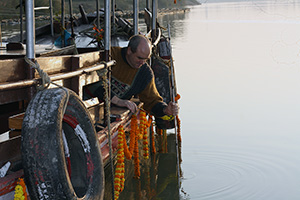River Ganga’s Power
By Bhumi Dasi | Jan 25, 2013

The Oxford Centre for Hindu Studies, in partnership with the Alliance of Religions and Conservation, is addressing the need for custodianship of pilgrim sites within India. They have begun the Bhumi Project, an endeavor aimed to create awareness regarding the effects of pilgrimage on the environments of holy refuges.
In November, Bhumi Dasi attended a conference on this subject as the representative of the Temple of the Vedic Planetarium. Many pilgrimage towns were represented for a weekend of discussions centering on planning the environmental sustainability of these revered sanctums.
Spiritual havens in India attract millions of visitors each year as they offer their obeisances to treasured deities and honor sites of worship. Grand festivals glorifying significant gods are auspicious milestones in the calendars of many. Attendance is welcomed and the festivities abound with joy.
However, while each step of a parikrama and each esteemed celebration are invaluable tributes, the aftermath of such glorification remains the responsibility of the local communities. Considerations such as green energy, trash disposal and recycling are among the many topics needing attention to ensure that the environmental impact on these respected places of homage is contained.
Since the Temple of the Vedic Planetarium will be a prominent feature in Mayapur and the surrounding areas, the management and planning officials of the project have assumed the responsibility of stewards of the local communities. Several progressive technologies will be employed in the new temple, the most exciting being one which will harness the natural power of Mother Ganga.
Called a hydrokinetic turbine, the system is simple technology and easy to build. It has a proven history of successful installations worldwide on slow running rivers and canals. An area of the Ganga has been found which is deep enough and has enough speed to accommodate the needs of this small device. The turbine will float like a boat in the river and a single installation will produce approximately 75 kilowatts per hour. This translates into producing nearly half of Mayapur’s daily 4000 kilowatt consumption in 24 hours.
Additionally, the hydrokinetic turbine is safe for the aquatic life and natural habitat in the river due to its slow rpm, open structure and silent operating.
Building a spiritual city is a huge undertaking requiring the dedication and forethought of many. The directors of the ToVP recognize the duties of their positions and work tirelessly to commemorate the sanctity of Mayapur in thought, word and deed.
For more information on the Bhumi Project, please visit bhumiproject.org.












